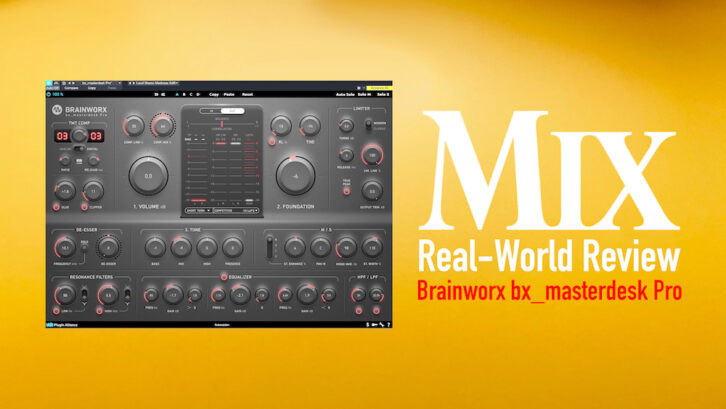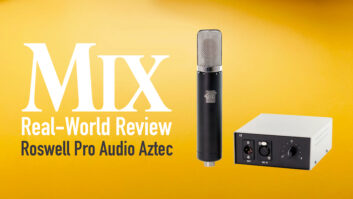
| MIX VERDICT: BRAINWORX BX_MASTERDESK PRO |
| THE TAKEAWAY: “Even if you’re a novice, its simple and intuitive controls will make it easy to get your mixes or masters sounding better.” |
| COMPANY: Brainworx (Plugin Alliance) • www.pluginalliance.com PRICE: $199 purchase, or included in certain Plugin Alliance Subscriptions. PROS: • Excellent sound quality. • Glue, Clipper and XT compressor features add impressive analog-like characteristics. • Stereo image adjustment even more powerful. • Limiter more adjustable. CONS: • No Integrated LUFS setting on meters. • No level matching for comparing with processing on or off. |
With more home-based musicians and producers doing their own mastering, the need for DIY mastering software has increased. Some such products are AI-infused, offering automatic settings based on an analysis of the audio. With its bx_masterdesk line, however, Brainworx takes a different approach, providing a suite of excellent and easy-to-use tools for shaping frequency and dynamics that relies on the user to create the settings.
bx-masterdesk Pro is the latest version and is conceptually similar to its predecessors—bx_masterdesk Classic (a free version), bx_masterdesk, and bx_masterdesk True Peak—but with many more features.
THE LOOK
If you’ve used previous versions, the first thing you’ll notice when you open bx_masterdesk Pro is that the GUI has a new, more modern look featuring a dark gray background with red accents. The single-screen interface is taller to fit the increased number of controls.
Gone is the VU meter, replaced by a more extensive, bar graph-style metering section containing six different readouts. From left to right are meters for True Peak, RMS, Gain Reduction, Dynamic Range and LUFS. Clicking in any of the meters resets its measurements, which is a handy feature.
For the LUFS meter, I was surprised to find no measurement for Integrated LUFS, just the Short Term and Momentary varieties. Considering that most streaming service targets are expressed in Integrated LUFS (an average LUFS reading over a song or an extended sample), I expected that a tool like bx_masterdesk Pro would include it.
Another metering improvement consists of horizontally oriented stereo balance and correlation meters near the top of the metering section. Also included are buttons to switch the entire metering section from its default, which shows Output levels, to Input.
Helpful as the metering section is, I found it a little challenging to see the small details, particularly on the LUFS meter. Fortunately, Brainworx allows you to increase the GUI to 125 or 150 percent. At either of those settings, everything was perfectly clear.
You can think of bx_masterdesk Pro as having three basic types of processing: dynamics/loudness, EQ and stereo image. For each type, the software offers more than one processing tool.
LEVELS AND COMPRESSION
I found it helpful to start by selecting a loudness target from the pulldown at the bottom of the meter. Among the choices are Loud (-6 dB), Louder (-8 dB), Streaming (-14 dB), and EU, U.S. or Japanese broadcast (-23 dB, -24 dB and -24 dB, respectively). A Custom setting lets you enter your own target level.
Setting a target doesn’t automatically make the plug-in output at your selected level. Instead, it calibrates the LUFS meter to turn red when the level exceeds your target, so getting that set before you start with other adjustments is best.
Especially when doing LUFS and True Peak measurements, it’s useful to reset the meter to get a more accurate analysis after you’ve made a change. Brainworx makes it easy—you just click inside any meter to reset it.
Brainworx added valuable features to the Compressor and beefed up some existing ones. As in previous versions, the Volume knob lets you adjust input gain. Turning it up will hit the compressor harder, triggering more gain reduction.
Unlike previous bx_masterdesk releases, the new version gives you 10 different TMT (Tolerance Modeling Technology) channels instead of four. (The idea of TMT is that each channel sounds slightly different based on the variations from the tolerance ranges of analog components.) It’s best to audition the different ones to see which sounds best with the song you’re working on.
The compressor now offers a variable ratio control with four preset choices: 3.2:1, 4.5:1, 6.2:1 and 7.9:1. Brainworx also added a variable Release control.
Glue and Clipper are two new compression controls. Each has a knob for dialing in as much of the effect as you want.
Glue emulates VCA bus compression (presumably an SSL bus compressor). The Clipper reduces transients that exceed 0dBFS, allowing the audio to sound louder.
I found that the Glue and Clipper processes added highly pleasing analog-like warmth and apparent loudness. I also was impressed with the compressor’s new XL knob. Turning it up produced third- and fifth-order harmonics for additional richness.
TONING UP
Like the compressor, the EQ controls of bx_ masterdesk Pro are plentiful.
The Foundation knob is an excellent place to start for frequency adjustments. It impacts the overall tonality of a song between bass and treble. At its 12 o’clock default, it has no effect. Turning it to the left increases the bottom end, and turning to the right, the high end. I only used it for minor adjustments, mostly to add extra low end. High settings, particularly toward the treble side, sounded too extreme.
For more subtle EQ tweaks, you can use the Tone Stack (another feature carried over from previous versions), which includes Bass, Mid, Treble and Presence knobs that offer plus-or minus 3 dB adjustments.
DPA 2012 and 2015 Cardioid Mics – A Mix Real-World Review
New to the Pro version is the Equalizer section, which provides three fully parametric bands. Turning the Q down in the Low or High band switches the EQ to a Low or High Shelving filter.
The Low band ranges from 20 to 2000 Hz. The Mid band is impressively wide, from 20 Hz to 20 kHz. The High band goes from 2 kHz to 22 kHz. A convenient Bypass button lets you toggle the 3-band EQ on and off to compare your settings. Also new are Low and High Pass filters.
Placed at the end of the effects chain, the De-Esser section is designed for taming harsh high-end, such as overly loud cymbals.
It’s been improved with the addition of a frequency adjust knob, which allows you to fine-tune the part of the signal where you want to aim the De-Esser.
Brainworx also added adjustable frequency knobs to the Resonance Control. Pressing the Auto-Solo button allows you to hear only the affected frequencies when you make a change.
BURNISHING YOUR IMAGE
The M/S section, designed for manipulating the stereo image, was significantly upgraded. In addition to the existing Mono Maker and Stereo Width knobs, Brainworx added a Stereo Enhance section with four different modes.
The Stereo Enhance circuit is a proprietary one that the manual says is designed to “get that extra boost and width for your synths or guitars without boosting unwanted boomy frequencies in your drums or raising the muddy parts of your reverb tails too much.”
It works well. In conjunction with the other controls in the section, I was able to significantly adjust the stereo image without negatively affecting mono-compatibility. Also new is the Pan M (mono) knob, which lets you re-center an unbalanced stereo image.
SETTING LIMITS
The last stop in the signal chain is the Limiter Section, which has also been souped up. The Turbo knob lets you adjust the gain before it hits the Limiter. Choose one of two attack modes: Modern or Classic. The former is faster. Also new and useful is a Release Time knob.
The True Peak button, when activated, prevents inter-sample peaks, which can cause distortion after analog conversion. The new Limiter Link knob governs whether the Limiter will attenuate both channels independently—which can cause imbalances in the stereo image—or react to the highest peak between the two.
Because mastering decisions are driven mainly by the characteristics of the audio being processed, you might think that using a preset as a starting point wouldn’t be that helpful, but that’s not the case with bx_masterdesk Pro.
Its 26 excellent presets—some targeted at specific genres—are a handy way to quickly audition different mastering approaches; you might even like one so much that you use it as the basis for your setting.
Brainworx didn’t include one feature that would be extremely helpful for A/Bing your new settings against your original file: level matching. Matching the levels when comparing keeps you from getting tricked by the “louder is better” effect.
In order to A/B accurately, I had to reduce the Output knob on the Limiter until I found the setting that matched the level of the unprocessed file before comparing. In a future version, I would love to see level matching built in, and also a facility for loading reference audio files.
GOING PRO
I’ve tried previous versions of bx_masterdesk. While I found them helpful, I usually opted for AI-based mastering software to analyze my audio and create starting-point settings, especially for the EQ adjustments, but bx_masterdesk Pro sounds so good and offers so much control that I’ve been getting excellent results without the AI. Not only is it great for mastering, but it also works well as an insert on the master bus, or even an instrument bus.
I love the sound of the new Glue, Clipper and XL features on the compressor. They work exceptionally well for adding a pleasing, warm sheen to the music. The new Stereo Enhance section provides a level of image control that I’ve not found elsewhere.
The more experienced you are, the more you’ll be able to get from bx_masterdesk Pro, but even if you’re a novice, its simple and intuitive controls will make it easy to get your mixes or masters sounding better and help you adjust them to the desired target level for your intended destination.







